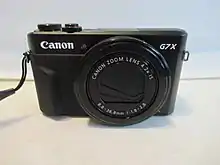 | |
| Overview | |
|---|---|
| Maker | Canon |
| Type | Large sensor fixed-lens camera |
| Lens | |
| Lens | 24-100 mm equivalent |
| F-numbers | f/1.8-f/2.8 at the widest |
| Sensor/medium | |
| Sensor type | BSI-CMOS |
| Sensor size | 13.2 × 8.8 mm (so-called 1 inch type, actually 0.18 square-inch) |
| Maximum resolution | 5472 × 3648 (20 megapixels) |
| Film speed | 125-12800 |
| Recording medium | SD, SDHC, or SDXC memory card |
| Focusing | |
| Focus areas | 31 focus points |
| Shutter | |
| Shutter speeds | 1/2000s to 40s |
| Continuous shooting | 6.5 frames per second |
| Image processing | |
| Image processor | DIGIC 7 |
| White balance | Yes |
| General | |
| LCD screen | 3 inches with 1,040,000 dots |
| Dimensions | 103 × 60 × 40 mm (4.06 × 2.36 × 1.57 inches) |
| Weight | 304 g including battery |
The Canon PowerShot G7 X is a compact digital camera announced by Canon Inc on September 15, 2014.[1] It did not replace any model in the Canon line-up. Instead, it was a new camera intended to compete with the Sony Cyber-shot DSC-RX100-series cameras. With the introduction of G7 X, there were three parallel models in the Canon PowerShot G-series: G16, G1 X Mark II, and G7 X.
In 2016, Canon introduced the Canon Power Shot G7 X Mark II with a newer DIGIC 7 processor.
In 2019, Canon introduced the G7 X Mark III. However, it was criticized for its autofocus issues.

Canon PowerShot G7 X Mark II
Sample photos
 Zoomed in photo (approximately 20x)
Zoomed in photo (approximately 20x) Photo taken under cloudy conditions
Photo taken under cloudy conditions
See also
References
- ↑ "Canon PowerShot G7 X Review". DPReview. Retrieved 2020-01-27.
This article is issued from Wikipedia. The text is licensed under Creative Commons - Attribution - Sharealike. Additional terms may apply for the media files.